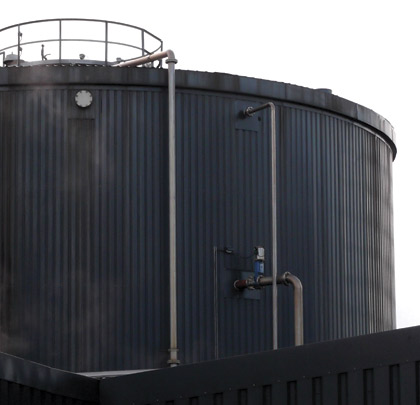Farmers don’t work nine to five and neither do biogas plants. At LBT Agro in Denmark, their anaerobic digestion operation is more like 24/7, with the family-run business now beginning to reap the rewards for their truly determined efforts to bring the best out of their plant.
QUALITY IS THE STANDARD
The journey of the Thomsen family to the point now where their gas production is three times greater than before, is testament to anyone who believes in first-class equipment and doesn’t take no for an answer. Chuck everything in the tank, mix it up a bit, and get some gas? Not here.
Back in 2002 the Hjørring Municipality decided to invest in AD and utilize the town’s wastewater for the production of biogas. At the time, Mr. and Mrs. Thomsen (Lars and Helle) were pig farmers, also producing crops of strawberries.
“The concept was fine, with everyone in the local community supposedly set to benefit in the long term,” says Lars. “But the Municipality’s modus operandi was very much Monday to Friday. They seemed to think that you could just switch everything off on a Friday afternoon and start it all up again on a Monday morning with everything instantly working properly, but we knew that AD doesn’t work like that.”

FINDING THE RIGHT EQUIPMENT
Mixing equipment not designed for this purpose also contributed heavily to the plant’s lack of performance—and in 2006, everything stopped completely when the money ran out. After much consideration, the Thomsen family decided to buy the plant.
“At first we had to spend much time just clearing everything up and getting some proper systems in place,” explains Lars, “but we always believed in having the best tools to do the best job, and after making such an investment we had every incentive to make it work for our livelihood.”
As LBT Agro, the Thomsens inherited top-entry mixers for the digesters, but soon found that a thick crust would often form on the surface. Depending on the type of feedstock, the mixers would block regularly, creating a downtime nightmare of more than a week, with the whole tank having to be emptied and gas production lost. Determined to succeed, the Thomsens sold their pig farm in 2008 so that they could concentrate more on optimizing their AD plant.
“We didn’t want to limit ourselves with only certain types of feedstock because that was all the mixers could cope with,” adds Lars, “and of course we wanted to significantly increase the amount of gas we were producing. We looked, as we still do today on constantly focusing on how we can improve, making a breakthrough in 2011 when we installed two Landia mixers into our secondary digester, which proved extremely reliable. This gave us more confidence.”
ROOM FOR EXPANSION
In 2012, the Thomsens invested in chickens, adding their manure to the feedstock and reducing their dependency and costs on importing it from elsewhere. The three chicken sheds (with plans for more) already process over one million birds anually.
Helle Thomsen takes up the story. “Things have really taken off with our gas production since we brought in Landia’s GasMix digester mixing system at the beginning of 2014. For the first time we saw that the whole tank was being mixed properly. Everything is now reduced down into small particles so we get more into the system and get more gas out. It has been a revelation.”
She adds, “GasMix has reduced our dry solids by around 15-20 percent and it has made a huge difference to our gas production, which is three times greater than what it was previously.”
GASMIX METHANE PRODUCTION
Designed with an externally-mounted chopper pump that recirculates a mixture of sludge and biogas, GasMix produces methane levels that exceed the energy required for operating the mixing system.
Frederik Thomsen (son of Lars and Helle) adds, “It’s not just the extra gas. We benefit very much from GasMix being externally mounted. It is very reliable, but when we carry out preventive maintenance, there is no downtime. Everything is very easy to get to—outside the tank. The previous pumps caused crust, as well as foaming—and they also couldn’t handle straw, even though we macerate it first down to 5 cm lengths. GasMix keeps on working.”
A VALUED PARTNERSHIP
Today LBT Agro has three 74,160-cubic foot capacity digesters, producing, with power supplied to the grid via a 4.3-mile pipeline into Hjorring. Heat that used to be lost is now utilized for the chicken sheds and to Hjørring heatsupply.
Lars Thomsen concludes, “We are very pleased with how far we’ve come, from what was far more complicated than just a standing start. We exchange our end-product fertilizer with farmers for feedstock, but this pile has seen a massive reduction in size because of the GasMix breaking down solids into such small particles, resulting in such good gas yields. We didn’t just invest in a digester mixing system. We also invested in the company behind it. Landia understands biogas and has been with us every step of the way as we keep working to fine-tune our AD operation.” ◆
About The Author
Soren Rasmussen is the director of Landia, Inc.
For more information about Landia’s range of applications, call 919.466.0603, email info@landiainc.com, or visit www.landiainc.com.
____________________________________________
MODERN PUMPING TODAY, December 2015
Did you enjoy this article?
Subscribe to the FREE Digital Edition of Modern Pumping Today Magazine!
![]()


